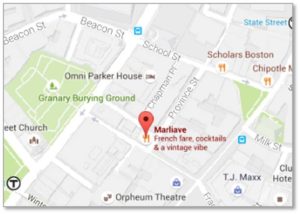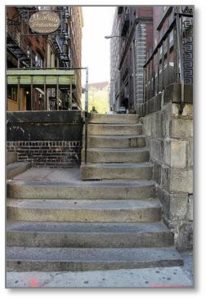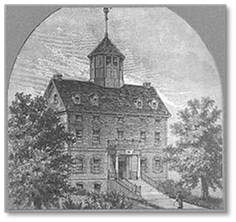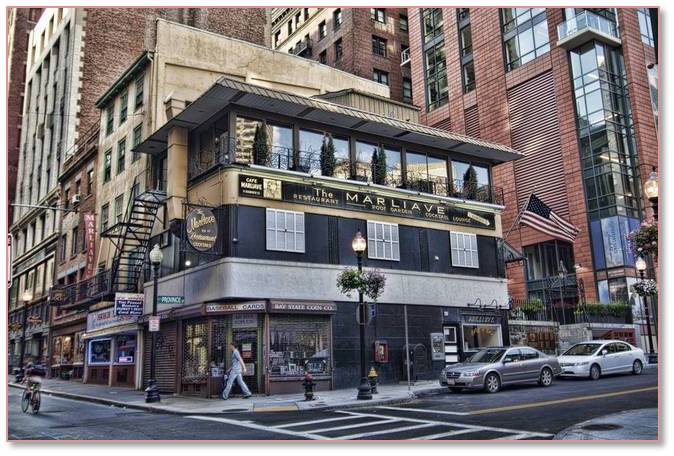This is the 20th post in my series
on Boston’s Hidden Gems.
I have written before about Boston’s ghosts—the specters of buildings, streets, monuments, docks, and towers that no longer exist. Sometimes they vanish entirely like the Great Elm and we are fortunate if a plaque marks the spot. Sometimes, like the Exchange Staircase, they leave little bits behind as persistent reminders of their former glory.
The Province House Steps offer one such remnant. Located on Province Street in Boston’s Downtown Crossing neighborhood, the steps appear as unobtrusive granite stairs leading steeply up from the sidewalk to the narrow end of Bosworth Street. Unless you notice the two plaques on the stone wall to the left of the steps you wouldn’t think any more of them than I did when I was a college student.
The Province House
But the steps tell an interesting tale because they once led to the tiered garden and orchards behind the house in which resided the royal governors of the Province of Massachusetts Bay. Peter Sergeant, a London merchant, originally built the house 1679 in the Jacobean style with bricks imported from Holland. Architectural Historian Abbott Lowell Cummings called it, “One of the most ambitious houses erected in seventeenth-century New England.” Sergeant’s home was known for impressive features such as the 51-foot-long façade, the great main staircase and Tudor-style chimney stacks on both ends.
In 1716 the provincial government acquired the house for £2,300 to serve as the residence of the royal governor. it improved both the interior and the exterior so that the royal governor would no longer have to officiate from the Town House, known today as the Old State House.
They installed a carved and gilded Royal Coat of Arms over the front door to advertise the King’s authority. Six royal governors, from Samuel Shute to William Howe, lived there.
100 Years of Available Space
After the American Revolution, the Massachusetts governor and his council occupied the house until Charles Bulfinch’s new State House was completed in 1798. Maintenance declined in the hard times after the war and in 1811 the house was deeded to Massachusetts General Hospital as an endowment. The hospital trustees leased it out for 99 years to developer David Greenough without any restrictions. The Province House served simply as available space, becoming in turn a tavern, an opera house, an amusement hall, and a lodging house as well as tradesmen’s shops.
Over time the Province House suffered great indignities. Its chimney stacks were chopped off and a coat of stucco was slapped on it in 1851. A fire in 1864 nearly gutted the interior. On the other hand, it became famous as the setting for the stories in Nathanial Hawthorne’s “Legends of the Province House,” which was later published as “Twice-told Tales.”
In 1869 the 99-year lease expired and the Province House reverted to Massachusetts General Hospital. Olympia Theaters acquired the building in 1922 and demolished it to make way for a new theater. This final insult proceeded despite the best efforts of William Sumner Appleton. Mr. Appleton founded the New England Society for the Preservation of Antiquities, now known as Historic New England, as part of his 22-year effort to protect the Province House.
Province House Steps Link Three Centuries
Today the Province House Steps, dating from the seventeenth century, lead up to a space that bridges the nineteenth and twenty-first centuries. On the left is the Café Marliave and on the right is 45 Province Street, a 32-floor luxury residential building.
Henry Marliave, a French immigrant from Paris, opened the Café Marliave at 10 Bosworth Street in 1885. With a brief hiatus, it has operated at this site for 131 years and is the fourth oldest restaurant in the city. Although this three-story building lacks architectural distinction, the vintage design and interior have been faithfully restored. Order the butterscotch pudding.
45 Province Street, which opened in 2009, was designed in glass and brick by Bruner-Cott Associates, “to bring together the best of old and new Boston.” The royal governors might not have used the gym or the pool but they would have appreciated the luxury.
Note: Two additional pieces of the Province House exist in Boston. The Royal Coat of Arms and the house’s Indian archer weathervane remain in the collection of the Massachusetts Historical Society at 1154 Boylston Street The weathervane is displayed in the Society’s front hall while the coat of arms can be seen at the Old State House on State Street. Other fragments found homes in several places outside the city.
Information and Directions
 The Province House steps rise from the north side of Province Street between Bosworth Street and School Street. You can reach them from four stops on the MBTA’s Green, Red and Orange lines: Park Street, State Street, Government Center and Downtown Crossing.
The Province House steps rise from the north side of Province Street between Bosworth Street and School Street. You can reach them from four stops on the MBTA’s Green, Red and Orange lines: Park Street, State Street, Government Center and Downtown Crossing.
If you come by car, park in the Boston Common Garage. Walk through the Common to Tremont Street. Walk northeast on Tremont, turn right on Bromfield Street, then left on Province Street. Look on your left to find the steps. Notice the plaques on the wall, including one that lists all the Governors of Massachusetts from Samuel Shute to Charlie Baker.
Boston’s Hidden Gems
- The Mapparium
- Boston Public Library Courtyard
- The Ether Dome
- The Tiffany Sanctuary
- The Salada Tea Doors
- Museum Restoration
- St. Francis Garden
- History Dioramas
- Exchange Staircase
- Pru Garden
- Angel of the Waters
- The Ayer Mansion Lobby
- The Catalonian Chapel
- The Vertical Garden on Merrimac Street
- The Vilna Shul
- The Great Elm on the Boston Common
- The Copley Station Headhouse
- The Rose Kennedy Rose Garden
- The North End’s Tiny Palazzo Ducale





My ancestor, Sir Charles Hobby, lived in Province House sometime after returning from the siege of Port Royal. As commander of the Ma militia he for a time was in charge of renamed Annapolius Royal. He was a merchant and captain and was knighted by Queen Anne in 1705. His daughter, Mary, was born at Province House. She married Zechariah Hubbard and died young after having a daughter, Mary. The Hubbards removed to Conn. where Mary married Peter Pond whose family came with John Winthrop to Boston in 1630. Mary and Peter Ponds grandson, Charles Hobby Pond became governor of Conn in 1843. The Ponds were half-relatives of Gov Wintrop. Rev. Thomas Hooker, founder of Hartford and the state of Conn., Via Newton descendants connected to the Ponds in Milford, st with marriage of Susannah ponds son, Jasper
Mallory to Harriet newton.
Thanks for this information, Mallory. It’s fascinating background.